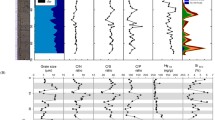Abstract
The populations of Beggiatoa species were quantified in the sediments of a brackish fjord (Limfjorden, Denmark) over a period of 1 year. The bacterial distribution was compared to the physical structure of the sediment, the redox profile, the concentration and production rate of H2S, and the rate of O2 consumption. The bacteria are absent in fine and in medium-grained sand, but in muds which are aggregated in faecal pellets very high population densities are found throughout the year with average biomasses of 5 to 20 g m-2. The bacteria seldom form coatings on the surface, but are distributed within the upper few centimeters of oxic sediment. They receive H2S partly from the lower anoxic layers and partly from reduced microniches scattered in the oxidized zone. Estimates of their metabolic rates indicate that Beggiatoa spp. may play a significant role in the sulfur and carbon cycles of the investigated sediments.
Similar content being viewed by others
Literature Cited
Almgren, T. and I. Hagström: The oxidation rate of sulfide in sea water. Wat. Res. 8, 395–400 (1974)
Buchanan, R.E. and N.E. Gibbons (Eds.): Bergey's manual of determinative bacteriology, 8th ed. 1246 pp. Baltimore: The Williams & Wilkins Company 1974
Crozier, W.J. and T.J.B. Stier: Temperature characteristics for speed of movement of thiobacteria. J. gen. Physiol. 10, 185–193 (1926)
Dale, N.G.: Bacteria in intertidal sediments: factors related to their distribution. Limnol. Oceanogr. 19, 509–518 (1974)
Faust, L. and R.S. Wolfe: Enrichment and cultivation of Beggiatoa alba. J. Bact. 81, 99–106 (1961)
Fenchel, T.: The ecology of marine microbenthos. IV. Structure and function of the benthic ecosystem, its chemical and physical factors and the microfauna communities, with special reference to the ciliated Protozoa. Ophelia 6, 1–182 (1969)
Gemerden, H. van: On the bacterial sulphur cycle of inland waters, 110 pp. Thesis, University of Leiden 1967
Golterman, H.L. (Ed.): Methods for chemical analysis of fresh waters, 188 pp. IBP Handbook No. 8. Oxford: Blackwell Scientific Publications 1971
Hemmingsen, A.M.: Energy metabolism as related to body size and respiratory surfaces, and its evolution. Rep. Steno meml Hosp. 9, 1–110 (1960)
Ivanov, M.V.: Microbiological processes in the formation of sulfur deposits, 298 pp. Jerusalem: Israel Program for Scientific Translations 1968
Jørgensen, B.B.: The sulfur cycle of a coastal marine sediment (Limfjorden, Denmark). Limnol. Oceanogr. (In press). (1977a)
—: Bacterial sulfate reduction within reduced microniches of oxidized marine sediments. Mar. Biol. 41, 7–17 (1977b)
— and T. Fenchel: The sulfur cycle of a marine sediment model system. Mar. Biol. 24, 189–201 (1974)
Kanneworff, E. and W. Nicolaisen: The “Haps”, a frame supported bottom corer. Ophelia 10, 119–128 (1973)
Kowallik, U. and E.G. Pringsheim: The oxidation of hydrogen sulfide by Beggiatoa. Am. J. Bot. 53, 801–806 (1966)
Kuenen, J.G.: Colourless sulfur bacteria and their role in the sulfur cycle. Pl. Soil 43, 49–76 (1975)
Lackey, J.B.: Occurrence of Beggiatoa species relative to pollution. Wat. Sewage Wks 108, 29–31 (1961)
Pamatmat, M.M.: Oxygen consumption by the seabed. IV. Shipboard and laboratory experiments. Limnol. Oceanogr. 16, 536–550 (1971)
Pringsheim, E.G.: Heterotrophism and species concept in Beggiatoa. Am. J. Bot. 51, 898–913 (1964)
—: Die Mixotrophie von Beggiatoa. Arch. Mikrobiol. 59, 247–254 (1967)
Reimers, T.: Anoxische Lebensräume. Struktur und Entwicklung der Mikrobiozönose an der Grenzfläche Meer/Meeresboden, 134 pp. Thesis, Zoological Institute, University of Kiel 1976
Scotten, H.L. and J.L. Stokes: Isolation and properties of Beggiatoa. Arch. Mikrobiol. 42, 353–368 (1962)
Sokolova, G.A. and G.I. Karavaiko: Physiology and geochemical activity of thiobacilli, 283 pp. Jerusalem: Israel Program for Scientific Translations 1968
Sorokin, Y.I. and H. Kadota (Eds.): Microbial production and decomposition in fresh waters, 712 pp. IBP Handbook No 23. Oxford: Blackwell Scientific Publications 1972
Winogradsky, S.: Beiträge zur Morphologie und Physiologie der Bacterien. I. Zur Morphologie und Physiologie der Schwefelbacterien, Leipzig: Arthur Felix 1888
Author information
Authors and Affiliations
Additional information
Communicated by T.M. Fenchel, Aarhus
Rights and permissions
About this article
Cite this article
Jørgensen, B.B. Distribution of colorless sulfur bacteria (Beggiatoa spp.) in a coastal marine sediment. Marine Biology 41, 19–28 (1977). https://doi.org/10.1007/BF00390577
Accepted:
Issue Date:
DOI: https://doi.org/10.1007/BF00390577



